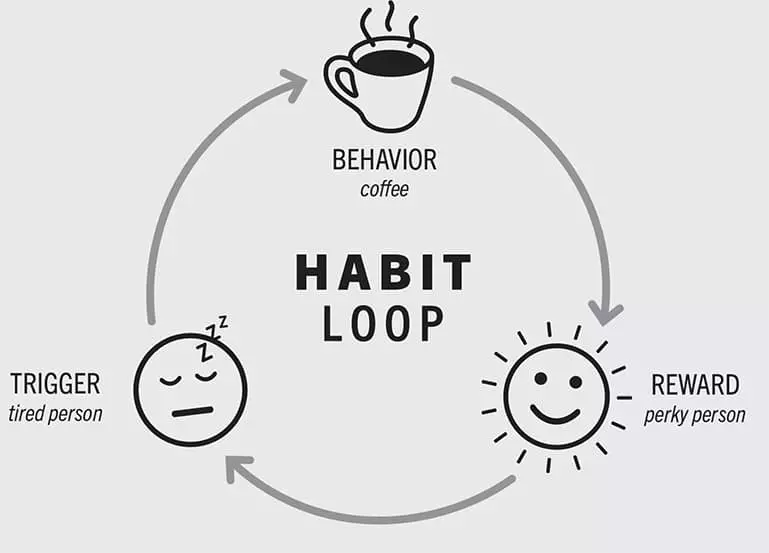Are you struggling to build new habits that stick? Trust me, I know how challenging it can be. But don’t worry, it’s not impossible. In fact, forming a new habit can be a lot easier if you follow a simple framework that breaks down the process into four stages.
These stages are the key to building a habit that will help you achieve your goals, whether it’s exercising more, eating healthier, or improving your productivity. So, if you’re ready to make a positive change in your life, let’s dive into these four stages and get started on building your new habit today!

Cue
Have you ever found yourself wanting to make a change in your life? Maybe you’ve noticed some extra weight creeping on, or perhaps you’re feeling more stressed than usual. Whatever it is, that feeling of wanting to improve is what we call the cue.
This is the first step in forming a habit, and it’s crucial for making any sort of change in your life. You need to be aware of the cue, and really hone in on what it is that you want to change. Is it a certain behavior, a lack of motivation, or a specific situation that triggers your bad habits? Whatever it is, identify it and make note of it.
The cue is like the starting point of a race. It’s what prompts you to take future action and start building a new habit. Without it, you may never even begin to think about changing your habits.
So, take some time to reflect on your life and identify the cue that’s been nudging you to make a change. Once you have a clear understanding of what’s prompting you to take action, you’ll be one step closer to forming a new habit.
Remember, it’s okay if you don’t have it all figured out just yet. The important thing is to start paying attention to the cues in your life, and be open to making a positive change.
Craving
Alright, so we’ve talked about the first step in forming a habit – the cue. But what happens next? Well, that’s where craving comes in.
Craving is the desire for change. It’s what pushes you to take action and start building a new habit. But here’s the thing – you can have a cue and still not have a strong enough craving to actually do anything about it.
Have you ever found yourself wanting to make a change, but never actually following through? Maybe you’ve set a goal for yourself, but always seem to fall short. That’s because your craving isn’t strong enough to motivate you to take action.
So, how do you increase your craving for change? It’s all about finding your “why”. Why do you want to form this new habit? What will it bring to your life? Will it make you happier, healthier, or more productive?
Take some time to reflect on your why. Get really clear on what it is that you want to achieve, and why it’s important to you. Once you have a strong enough craving, you’ll be much more likely to take action and start forming that new habit.
It’s okay if your craving isn’t super strong at first. It takes time to build up that desire for change. But the more you focus on your why, the easier it will become to stay motivated and make progress towards your goals. So, what are you craving? Let’s start building that new habit today!
Response
Now that we’ve covered the importance of having a strong craving for change, let’s move onto the next step in forming a new habit – the response.
This is where things can get a bit tricky. It’s one thing to recognize that you need to make a change, but it’s another thing entirely to actually take action and start forming that new habit.
Breaking an old, bad habit and replacing it with a new one can be particularly challenging. After all, you’ve probably been practicing that old habit for a long time, and it’s become ingrained in your daily routine.
So, how do you go about making a change? One approach that can be really helpful is the 2-Minutes rule. This rule suggests that you start by making a small change that takes only 2 minutes or less to do.
For example, if you want to start exercising every morning, you might begin by doing just 2 minutes of stretching or light exercise. The idea is to start small and gradually build up to more challenging habits over time.
The key to success with the 2-Minutes rule is consistency. By doing the new habit consistently, even if it’s just for 2 minutes a day, you’re reinforcing that behavior and making it more likely to stick.
Forming a new habit is a process, and it won’t happen overnight. But by starting small and being consistent, you can make real progress towards your goals. So, what small action can you take today to start forming that new habit? Give it a try and see how it feels!
Reward
The most exciting part of forming a habit! It’s where all your hard work starts to pay off, and you begin to see the changes you’ve been working so hard for. It’s like a pat on the back, and it motivates you to continue with your new habit.
But here’s the thing, over time, the reward can lose its appeal. You might start feeling like the results aren’t as exciting as they used to be, and you may even begin to lose motivation. This is why it’s essential to keep your focus on the long-term benefits of the habit you’re forming.
The best way to do this is by tracking your progress and celebrating milestones. This will help you see the bigger picture and remind you of why you started in the first place. You could even treat yourself to something you love after achieving a significant milestone. For example, if your goal was to exercise every day for a month, you could reward yourself with a spa day or a new workout outfit.
The key to maintaining a habit is consistency. Even if you don’t feel like it, push yourself to continue with your routine, and soon enough, it will become second nature to you. The rewards will keep flowing, and you’ll be amazed at how far you’ve come.
Additional Tips For Forming Habits
Forming a new habit can be challenging, but the good news is there are plenty of tips and tricks to help make it easier. One of the best things you can do is set a specific goal and write it down. This gives you a clear idea of what you want to achieve and helps you stay focused on your new habit.
Another useful tip is to start small and gradually increase the difficulty of the habit. For example, if you want to start exercising regularly, begin by taking a short walk each day and gradually increase the distance or intensity over time. This allows you to build up momentum and makes it easier to stick with the habit.
Tracking your progress is also crucial for forming a new habit. By monitoring your successes, you can see how far you’ve come and stay motivated to keep going. Celebrating your successes along the way can also help boost your confidence and make the habit feel more rewarding.
Having a support system or accountability partner can also be extremely helpful. This could be a friend or family member who shares your goal or a coach who can provide guidance and encouragement. They can help keep you motivated when the going gets tough and hold you accountable for sticking to your new habit.
Lastly, be patient with yourself and remember that forming a new habit takes time and effort. Don’t be too hard on yourself if you slip up or miss a day. Instead, focus on getting back on track and continuing to make progress towards your goal. With a little perseverance and the right approach, you can build the habits you need to live a happier, healthier life.





